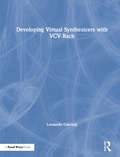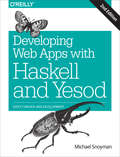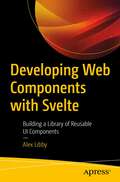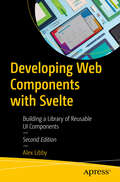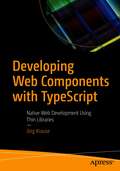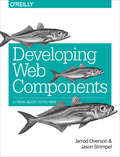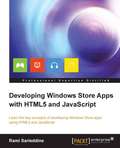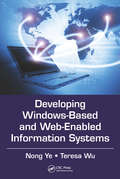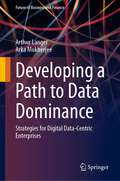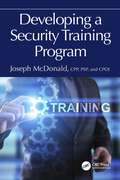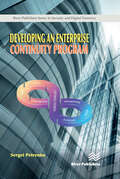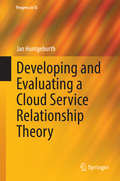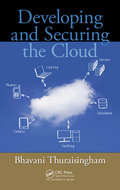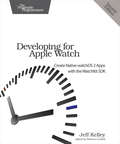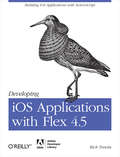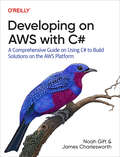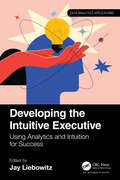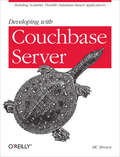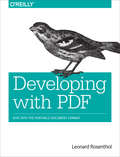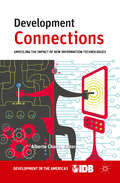- Table View
- List View
Developing Virtual Synthesizers with VCV Rack
by Leonardo GabrielliDeveloping Virtual Synthesizers with VCV Rack takes the reader step by step through the process of developing synthesizer modules, beginning with the elementary and leading up to more engaging examples. Using the intuitive VCV Rack and its open-source C++ API, this book will guide even the most inexperienced reader to master efficient DSP coding to create oscillators, filters, and complex modules.Examining practical topics related to releasing plugins and managing complex graphical user interaction, with an intuitive study of signal processing theory specifically tailored for sound synthesis and virtual analog, this book covers everything from theory to practice. With exercises and example patches in each chapter, the reader will build a library of synthesizer modules that they can modify and expand.Supplemented by a companion website, this book is recommended reading for undergraduate and postgraduate students of audio engineering, music technology, computer science, electronics, and related courses; audio coding and do-it-yourself enthusiasts; and professionals looking for a quick guide to VCV Rack. VCV Rack is a free and open-source software available online.
Developing Web Applications with Haskell and Yesod
by Michael SnoymanThis fast-moving guide introduces web application development with Haskell and Yesod, a potent language/framework combination that supports high-performing applications that are modular, type-safe, and concise. You'll work with several samples to explore the way Yesod handles widgets, forms, persistence, and RESTful content. You also get an introduction to various Haskell tools to supplement your basic knowledge of the language. By the time you finish this book, you'll create a production-quality web application with Yesod's ready-to-use scaffolding. You'll also examine several real-world examples, including a blog, a wiki, a JSON web service, and a Sphinx search server. Build a simple application to learn Yesod's foundation datatype and Web Application Interface (WAI) Use Shakespearean template languages for HTML, CSS, and Javascript output Produce cleaner, more modular code by learning how Yesod monads interact Implement the yesod-form declarative API to build forms on top of widgets Learn how Yesod and Haskell store session data and handle persistence Use techniques to serve an HTML page and a machine-friendly JSON page from the same URL Create reusable components for several applications with Yesod subsites
Developing Web Applications with Oracle ADF Essentials
by Sten E. VesterliDeveloping Web Applications with Oracle ADF Essentials covers the basics of Oracle ADF and then works through more complex topics such as debugging and logging features and JAAS Security in JDeveloper as the reader gains more skills. This book will follow a tutorial approach, using a practical example, with the content and tasks getting harder throughout."Developing Web Applications with Oracle ADF Essentials" is for you if you want to build modern, user-friendly web applications for all kinds of data gathering, analysis, and presentations. You do not need to know any advanced HTML or JavaScript programming. Business logic can be implemented by adding Java code at well-defined hook points, so you do not need do know advanced object-oriented programming--regular Java programming skills are enough.
Developing Web Apps with Haskell and Yesod: Safety-Driven Web Development
by Michael SnoymanThis fast-moving guide introduces web application development with Haskell and Yesod, a potent language/framework combination that supports high-performing applications that are modular, type-safe, and concise. Fully updated for Yesod 1.4, this second edition shows you how Yesod handles widgets, forms, persistence, and RESTful content. Author Michael Snoyman also introduces various Haskell tools to supplement your basic knowledge of the language.By the time you finish this book, you’ll create a production-quality web application with Yesod’s ready-to-use scaffolding. You’ll also examine several real-world examples, including a blog, a wiki, a JSON web service, and a Sphinx search server.Build a simple application to learn Yesod’s foundation datatype and Web Application Interface (WAI)Output HTML, CSS, and Javascript with Shakespearean template languagesGet an indepth look at Yesod’s core monads for producing cleaner, more modular codeProbe Yesod’s internal workings: learn the request handling process for a typical applicationBuild forms on top of widgets by implementing the yesod-form declarative APILearn how Yesod and Haskell handle persistence and session dataServe an HTML page and a machine-friendly JSON page from the same URL
Developing Web Components with Svelte: Building a Library of Reusable UI Components
by Alex LibbyLeverage the power of Svelte to quickly produce the foundations of a framework-agnostic component library that can extend and develop over time. This is a project-oriented book that simplifies setting up the skeleton of the library and adding components, using little more than a text editor or free software. You'll gain a starting baseline that can be used to develop future projects or incorporated into an existing workflow. You'll take development to the next level and can use this knowledge to create components with any framework, such as React, Angular or Vue.js, not just Svelte. Developing Web Components with Svelte is an excellent resource for getting acquainted with creating and maintaining a component library using a phased approach. It takes the view that you don't have to create something complex and unwieldy. Instead, you can start building something quickly, then extend it as needs dictate over time, without sacrificing speed or features. You'll see how to develop cleaner components in a quick, clear and straightforward way. The components you create in this project can be made available in one of the world's most extensive component ecosystems to be usable by other frameworks, making them genuinely reusable. In short, Svelte offers plenty of opportunities as it is based on Node.js and JavaScript making Svelte a powerful package to work from.What You'll LearnUse the Svelte framework to rapidly create and deploy the foundation of a component library that is versatile and performantReview developing and customizing components based on our needsWork through a real-world project to help solidify skills learned from the book and put them into practiceWho This Book Is ForWebsite developers, familiar with JavaScript, who are keen to learn how to leverage the Svelte framework fastAgile development teams, where time is of the essence, and the pressure is on to deliver results quicklyDevelopers who want to focus on simplicity, to produce efficient and optimized content in modern browsers using tools readily available
Developing Web Components with Svelte: Building a Library of Reusable UI Components
by Alex LibbyLeverage the power of Svelte to quickly produce the foundations of a framework-agnostic component library that can extend and develop over time. This is a project-oriented book that simplifies setting up the skeleton of the library and adding components, using little more than a text editor or free software. You'll gain a starting baseline that can be used to develop future projects or incorporated into an existing workflow. You'll take development to the next level and can use this knowledge to create components with any framework, such as React, Angular or Vue.js, not just Svelte. Developing Web Components with Svelte is an excellent resource for getting acquainted with creating and maintaining a component library using a phased approach. It takes the view that you don't have to create something complex and unwieldy. Instead, you can start building something quickly, then extend it as needs dictate over time, without sacrificing speed or features. You'll see how to develop cleaner components in a quick, clear and straightforward way. The components you create from this book can be made available for use in other frameworks such as React, Vue or Angular, making them genuinely reusable. In short, Svelte offers plenty of opportunities as it is based on Node.js and JavaScript, which makes it a powerful package to use. This New Edition Includes: New chapters covering animation components, accessibility concerns and Theming Extensively updated content and documentation to support changes in Storybook Updated to the latest spec of Svelte Reworked content and installation process for Storybook You'll Learn: To use the Svelte framework to rapidly create and deploy the foundation of a web component library that is versatile and performant To review developing and customizing components based on our needs To work through a real-world project to help solidify skills learned from the book and put them into practice Who This Book Is For: Website developers, familiar with JavaScript, who are keen to learn how to leverage the Svelte framework fast Agile development teams, where time is of the essence, and the pressure is on to deliver results quickly Developers who want to focus on simplicity, to produce efficient and optimized content in modern browsers using tools readily available
Developing Web Components with TypeScript: Native Web Development Using Thin Libraries
by Jörg KrauseCreate professional and progressive web apps with the native HTML API on the latest technology stack. This book describes the basics of web components and how to create them using plain JavaScript as well as how to make professional applications based on web components using TypeScript.Developing Web Components with TypeScript looks at APIs using examples, techniques, and tricks. You will start with a brief introduction to web components, including slots and templates, handling custom events, and styling components with or without shadow DOM. Then, it introduces TypeScript as part of the tool set. It shows the internal construction of a professional thin library. It also helps you learn how to deal with web components in real-life projects; this includes techniques such as creating a single-page app without framework code. All code samples used here are supported by all modern browsers for you to follow along. Library code and examples are available on GitHub.What You Will LearnCreate isolated web components using shadow DOM, slots, and templatesUnderstand the advantage of an enhanced toolset, especially TypeScript Pick up styles and customizationsMaster professional web apps using native APIsUnderstand the life cycle of a component Who This Book Is For Professional developers who want to move from desktop to web and away from fat frameworks to achieve their goal.
Developing Web Components: UI from jQuery to Polymer
by Jarrod Overson Jason StrimpelAlthough web components are still on the bleeding edge—barely supported in modern browsers—the technology is also moving extremely fast. This practical guide gets you up to speed on the concepts underlying W3C’s emerging standard and shows you how to build custom, reusable HTML5 Web Components.Regardless of your experience with libraries such as jQuery and Polymer, this book teaches JavaScript developers the DOM manipulations these libraries perform. You’ll learn how to build a basic widget with vanilla JavaScript and then convert it into a web component that’s semantic, declarative, encapsulated, consumable, and maintainable. With custom components, the Web can finally fulfill its potential as a natively extensible application platform. This book gets you in at the right time.Understand core concepts (such as normal flow and positioning, and Z-index) for properly positioning, dragging, and resizing elementsExplore UI concepts and patterns typically abstracted away by Dojo, jQuery UI, Kendo UI, and other librariesDive into the W3C standard and convert your working widget example into a fully functioning web componentLearn how to encapsulate, package, and deploy your web components with Google’s Polymer framework
Developing Windows Store Apps with HTML5 and JavaScript
by Rami SarieddineThis book is a hands-on guide that follows a step-by-step tutorial approach which discusses Windows 8 application development with HTML5, CSS3, and JavaScript.This book is great for developers who want to start developing for Windows 8 and it also targets developers who want to get introduced to powerful advancements in standards-based web technology, while using it to build Windows Store apps, as well as leveraging their existing skills and code assets in web development.
Developing Windows-Based and Web-Enabled Information Systems (Data-Enabled Engineering)
by Nong Ye Teresa WuMany professionals and students in engineering, science, business, and other application fields need to develop Windows-based and web-enabled information systems to store and use data for decision support, without help from professional programmers. However, few books are available to train professionals and students who are not professional progra
Developing a Path to Data Dominance: Strategies for Digital Data-Centric Enterprises (Future of Business and Finance)
by Arthur Langer Arka MukherjeeMost existing companies struggle currently because they lack the tools and strategies to move product departments into independent platforms that can be retrofitted to form dynamic new products based on consumer demands. This book provides managers and professionals with the necessary approaches for designing software and hardware architectures to support data platform organizations. Specifically, it demonstrates how to automate the decomposition of existing platforms into smaller parts that can be reused to form new variations. This task requires significant analysis and design methodologies and procedures to create an infrastructure based on data as opposed to products. These new knowledge bases allow data-centric professionals to pursue actions that can better predict and respond to the unexpected. Featuring case examples from companies such as Lego, FedEx, General Electric (GE), Pfizer, P&G and more, this book is appropriate for C-level executives engaged in the digital transformation of their firms; entrepreneurs of digital platform companies; and senior software engineers that need to design Internet of Things (IoT) devices and integrate them with block chain and multi-cloud architectures. In addition, this book is also useful for graduate-level coursework in data science.
Developing a Security Training Program
by Joseph McDonaldDeveloping a Security Training Program focuses on how to establish a comprehensive training program for a security department from the ground up. This book highlights formal curriculum development, consistent and continual training, and the organizational benefits including how such security training will be a value-add.It’s long overdue for the industry to revisit old security training models from the past — to both general staff as well as to the dedicated security staff and professionals within organizations — and examine and revamp such with a fresh perspective. Given the current, dynamic environment for businesses — and the threats businesses face — it is important that any such training consider all procedures and policies, and be fully integrated into the company culture. This includes maintaining an eye on budgetary and financial costs while recognizing the need to budget for more training resources to maintain resilience and adaptability to current challenges and future changes to the environment. There is only one way to prepare your staff and that is through comprehensive and consistent training.Developing a Security Training Program provides the blueprint and tools for professionals to provide ongoing, targeted, and comprehensive security training at a low, budget-friendly cost.
Developing an Enterprise Continuity Program
by Sergei PetrenkoThe book discusses the activities involved in developing an Enterprise Continuity Program (ECP) that will cover both Business Continuity Management (BCM) as well as Disaster Recovery Management (DRM). The creation of quantitative metrics for BCM are discussed as well as several models and methods that correspond to the goals and objectives of the International Standards Organisation (ISO) Technical Committee ISO/TC 292 "Security and resilience”. Significantly, the book contains the results of not only qualitative, but also quantitative, measures of Cyber Resilience which for the first time regulates organizations’ activities on protecting their critical information infrastructure.The book discusses the recommendations of the ISO 22301: 2019 standard “Security and resilience — Business continuity management systems — Requirements” for improving the BCM of organizations based on the well-known “Plan-Do-Check-Act” (PDCA) model. It also discusses the recommendations of the following ISO management systems standards that are widely used to support BCM. The ISO 9001 standard "Quality Management Systems"; ISO 14001 "Environmental Management Systems"; ISO 31000 "Risk Management", ISO/IEC 20000-1 "Information Technology - Service Management", ISO/IEC 27001 "Information Management security systems”, ISO 28000 “Specification for security management systems for the supply chain”, ASIS ORM.1-2017, NIST SP800-34, NFPA 1600: 2019, COBIT 2019, RESILIA, ITIL V4 and MOF 4.0, etc. The book expands on the best practices of the British Business Continuity Institute’s Good Practice Guidelines (2018 Edition), along with guidance from the Disaster Recovery Institute’s Professional Practices for Business Continuity Management (2017 Edition). Possible methods of conducting ECP projects in the field of BCM are considered in detail. Based on the practical experience of the author there are examples of Risk Assessment (RA) and Business Impact Analysis (BIA), examples of Business Continuity Plans (BCP) & Disaster Recovery Plans (DRP) and relevant BCP & DRP testing plans.This book will be useful to Chief Information Security Officers, internal and external Certified Information Systems Auditors, senior managers within companies who are responsible for ensuring business continuity and cyber stability, as well as teachers and students of MBA’s, CIO and CSO programs.
Developing and Evaluating a Cloud Service Relationship Theory
by Jan HuntgeburthThis book develops, evaluates and refines a cloud service relationship theory that explains how cloud users' uncertainties arise in these relationships and how they can be mitigated. To that end, the book employs principal-agent theory and the concepts of bounded rationality and social embeddedness. Beyond advancing IS research, the findings presented can greatly benefit governments, IT departments and IT providers, helping them to better understand cloud service relationships and to adjust their cloud service strategies accordingly.
Developing and Securing the Cloud
by Bhavani ThuraisinghamAlthough the use of cloud computing platforms and applications has expanded rapidly, most books on the subject focus on high-level concepts. There has long been a need for a book that provides detailed guidance on how to develop secure clouds.Filling this void, Developing and Securing the Cloud provides a comprehensive overview of cloud computing t
Developing for Apple TV using tvOS and Swift
by Gary Bennett Stefan Kaczmarek Brad LeesGary Bennett, Brad Lees, and Stefan Kaczmarek, the team behind Swift 2 for Absolute Beginners, brings you a hands-on "Swift" introduction to the new tvOS SDK with a collection of app projects to try out. You'll learn how to create a BookStore app for the TV, including using Stack Views for book details, how to create a photo gallery app, and how to use collection view and split view controllers with a music collection app. Finally, you'll also learn how to store Apple TV app data in iCloud. The new Apple TV is here, and it's open for your native apps -- Developing for the Apple TV with tvOS and Swift will get you started developing right away. What you'll learn How to use stack views in tvOS How to use collection views and split view controllers How to store Apple TV app data in iCloud How to create native apps for books, photos, and music on the Apple TV Who this book is for Intermediate iOS developers who want to create native Apple TV apps using the new tvOS SDK. Table of Contents Chapter 1: Getting Started with the New Apple TV Chapter 2: The tvOS Weather App Chapter 3: Stack Views and the Focus Engine Chapter 4: Creating a Photo Gallery App Chapter 5: Adding an Album Browser to the Photo Gallery App Chapter 6: Adding a Dynamic Top Shelf to the Photo Gallery App Chapter 7: Storing and Sharing Data Chapter 8: CloudKit
Developing for Apple Watch: Create Native watchOS Apps with the WatchKit SDK
by Jeff KelleyYou've got a great idea for an Apple Watch app. But how do you get your app from idea to wrist? This book shows you how to make native watchOS apps for Apple's most personal device yet. You'll learn how to display beautiful interfaces to the user, how to use the watch's heart rate monitor and other hardware features, and the best way to keep everything in sync across your users' devices. New in this edition is coverage of native apps for watchOS 2. With the new version of the WatchKit SDK in Xcode 7, your apps run directly on the watch.On Apple Watch, your app is right on your users' wrists, making your code closer than ever before. Create native watchOS apps by extending your iPhone app with a WatchKit Extension, giving your users quick access to your app's most important features and an intimate user experience that's always within arm's reach. You won't just be creating apps - with Glances to provide timely information, notifications to inform your users of the latest updates, and watch face complications to show your users data as soon as they raise their wrists, your watchOS apps will be the best the App Store has to offer. Any book can teach you how to make a watch app. This book will help focus your efforts and refine your app's feature set. Which features make sense on the watch? How should you organize them? You'll learn what to consider when judging watch app features, allowing you to come up with the best strategy for your app. You'll test your apps on real Apple Watch hardware, and by the end of this book, you'll be ready to ship to the App Store.What You Need:You'll need a Mac running OS X Yosemite capable of running Xcode 7 or later. To build your apps for your Apple Watch, you'll need to be running watchOS 2 or later, connected to a compatible iPhone.
Developing iOS Applications with Flex 4.5: Building iOS Applications with ActionScript
by Rich TretolaReady to put your ActionScript 3 skills to work on iPhone and iPad apps? This hands-on book walks you through the process of creating an Adobe AIR application for iOS devices from start to finish, using the Flex 4.5 framework. Move quickly from a basic Hello World application to complex interactions with iOS APIs, and get complete code examples for working with device components—including the accelerometer, GPS, camera, gallery, and multitouch display. This is an ideal resource for Flex developers of all levels.Use Flash Builder 4.5 to create and debug a Flex Mobile projectChoose a layout option to determine which files Flash Builder autogeneratesExplore APIs that enable your app to interact with the camera, accelerometer, and GPSRead and write text files, and create and write to an SQLite databaseInteract with the browser, place calls, and create emails and text messagesLoad content into your app with StageWebViewDesign for iOS with specific UI elements while maintaining one code version for all mobile devicesPublish your app to an Apple iOS installer file with Flash Builder
Developing on AWS with C#: A Comprehensive Guide on Using C# to Build Solutions on the AWS Platform
by Noah Gift James CharlesworthMany organizations today have begun to modernize their Windows workloads to take full advantage of cloud economics. If you're a C# developer at one of these companies, you need options for rehosting, replatforming, and refactoring your existing .NET Framework applications. This practical book guides you through the process of converting your monolithic application to microservices on AWS.Authors Noah Gift, founder of Pragmatic AI Labs, and James Charlesworth, engineering manager at Pendo, take you through the depth and breadth of .NET tools on AWS. You'll examine modernization techniques and pathways for incorporating Linux and Windows containers and serverless architecture to build, maintain, and scale modern .NET apps on AWS. With this book, you'll learn how to make your applications more modern, resilient, and cost-effective.Get started building solutions with C# on AWSLearn DevOps best practices for AWSExplore the development tools and services that AWS providesSuccessfully migrate a legacy .NET application to AWSDevelop serverless .NET microservices on AWSContainerize your .NET applications and move into the cloudMonitor and test your AWS .NET applicationsBuild cloud native solutions that combine the best of the .NET platform and AWS
Developing the Intuitive Executive: Using Analytics and Intuition for Success (Data Analytics Applications)
by Jay LiebowitzThe leading traits of executives often include creativity and innovation. Research shows that intuition can significantly enhance to these traits. Developing intuitive executives and honing intuition, coupled with the ability to apply data and evidence to inform decision making, is the focus of Developing the Intuitive Executive: Using Analytics and Intuition for Success. Some researchers call the complement of applying data analytics to intuition as quantitative intuition, rational intuition, or informed intuition. Certainly, in today's data-driven environment, analytics plays a key role in executive decision-making. However, an executive’s many years of experiential learning are not formally considered as part of the decision-making process. Learning from both failures and successes can help fine-tune intuitive awareness—what this book calls intuition-based decision-making. Research also shows that many executives do not trust the internal data quality in their organizations, and so they rely on their intuition rather than strictly on data. This book presents the work of leading researchers worldwide on intuition in the management and executive domain. Their chapters cover key issues, trends, concepts, techniques, and opportunities for applying intuition as part of the executive decision-making process. Highlights include: Using intuition to manage new opportunities Intuition in medicine Rules based on intuition Balancing logic and intuition in decision-making Smart heuristics to manage complexity Intuition and competitiveness Intuitive investment decision-making across cultures Showing how intuition in executive decision making should play an important role, this book enables managers to complement their knowledge gained from experience with analytics to improve decision-making and business success.
Developing with Couchbase Server: Building Scalable, Flexible Database-Based Applications
by Mc BrownToday’s highly interactive websites pose a challenge for traditional SQL databases—the ability to scale rapidly and serve loads of concurrent users. With this concise guide, you’ll learn how to build web applications on top of Couchbase Server 2.0, a NoSQL database that can handle websites and social media where hundreds of thousands of users read and write large volumes of information.Using food recipe information as examples, this book demonstrates how to take advantage of Couchbase’s document-oriented database design, and how to store and query data with various CRUD operations. Discover why Couchbase is better than SQL databases with memcached tiers for managing data from the most interactive portions of your application.Learn about Couchbase Server’s cluster-based architecture and how it differs from SQL databasesChoose a client library for Java, .NET, Ruby, Python, PHP, or C, and connect to a clusterStructure data in a variety of formats, from serialized objects, a stream of raw bytes, or as JSON documentsLearn core storage and retrieval methods, including document IDs, expiry times, and concurrent updatesCreate views with map/reduce and learn Couchbase mechanisms for querying and selection
Developing with Docker
by Jaroslaw KrochmalskiAbout This BookCut through the noise and in simple terms learn to package your applications and test, ship, and scale your containersFind and build images and successfully run your programs within containersBuild, deploy, and test your Docker containers and put them to work in productionWho This Book Is ForThis book is for IT professionals, system administrators, and DevOps professionals or anyone looking to quickly develop and deploy software to production at scale. If you are interested in Docker, DevOps, or containers in general, don't look any further.What You Will LearnUnderstand the concepts and architecture behind DockerInstall Docker on various platforms and explore tools such as Docker CLI or KinematicBuild, ship, and run distributed applicationsDeploy, automate, and manage the execution of applications within DockerScale and virtualize images and containersUtilize the networking and storage features that Docker offersLearn to run programs within containers and get to grips with the container lifecycle and cleanup processUse repositories to store and retrieve imagesIn DetailThis fast-paced and practical guide will get you up and running with Docker. Using Docker, you will be able to build, ship, and run many distributed applications in real time.Starting with an introduction to Docker, this book will cover precise and practical instructions to install Docker Toolbox on Mac, Linux, Windows, and Cloud. You will gain a deeper insight into the concepts and architecture of Docker. The book will cover different types of containers and their applications and show you how to find and build images. Next, you will learn about container networking the different types of Docker volumes. You will learn how to contribute to the image repository by publishing different images. This will familiarize you with the image building process and you will also be able to successfully run your programs within containers.By the end of this book, you will be well equipped in deploying your applications using Docker and will have a clear understanding of concepts, techniques, and practical methods to get it running in production systems.
Developing with Google+: Practical Guide to the Google+ Platform
by Jennifer MurphyWould you like to integrate Google+ with an existing website, or build your own social application on the platform? Developing with Google+ takes you on a tour of the Google+ APIs, with lots of concrete examples and hands-on projects. You’ll learn how to take advantage of Google+ social plug-ins, communicate programmatically with Google+ over REST APIs, and author real-time Hangout Apps.Over the course of this book, you’ll follow the progress of a fictional company, Baking Disasters, as it incorporates all the features of the Google+ platform.Make the most of social widgets such as the +1 button, Badge, and the Share buttonUse performance tuning techniques to speed up social plugins on your siteCreate your own plugins by accessing public data APIs with RESTful web servicesTransform an blog into a social web application through server-side processingUse OAuth to authenticate users and authorize your access to their private dataExtend Google+ Hangouts programmatically and create your own application
Developing with PDF: Dive Into the Portable Document Format (Oreilly and Associate)
by Leonard RosentholPDF is becoming the standard for digital documents worldwide, but it’s not easy to learn on your own. With capabilities that let you use a variety of images and text, embed audio and video, and provide links and navigation, there’s a lot to explore. This practical guide helps you understand how to work with PDF to construct your own documents, troubleshoot problems, and even build your own tools.You’ll also find best practices for producing, manipulating, and consuming PDF documents. In addition, this highly approachable reference will help you navigate the official (and complex) ISO documentation.Learn how to combine PDF objects into a cohesive wholeUse PDF’s imaging model to create vector and raster graphicsIntegrate text, and become familiar with fonts and glyphsProvide navigation within and between documentsUse annotations to overlay or incorporate additional contentBuild interactive forms with the Widget annotationEmbed related files such as multimedia, 3D content, and XML filesUse optional content to enable non-printing graphicsTag content with HTML-like structures, including paragraphs and tables
Development Connections
by Alberto ChongDevelopment Connections takes stock of recent advances in what is broadly known as Information and Communication Technologies (ICTs). The authors seek to discover how information and telecommunication technologies affect both the public and private sectors in Latin America and how they can optimize ICT returns to society.
